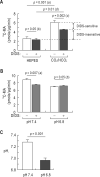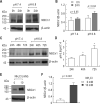Sodium-bicarbonate cotransporter NBCn1 in the kidney medullary thick ascending limb cell line is upregulated under acidic conditions and enhances ammonium transport
- PMID: 20591978
- PMCID: PMC2923243
- DOI: 10.1113/expphysiol.2010.053967
Sodium-bicarbonate cotransporter NBCn1 in the kidney medullary thick ascending limb cell line is upregulated under acidic conditions and enhances ammonium transport
Abstract
In this study, we examined the effect of bicarbonate transporters on ammonium/ammonia uptake in the medullary thick ascending limb cell line ST-1. Cells were treated with 1 mm ouabain and 0.2 mM bumetanide to minimize carrier-mediated NH(4)(+) transport, and the intracellular accumulation of (14)C-methylammonium/methylammonia ((14)C-MA) was determined. In CO(2)/HCO(3)(-)-free solution, cells at normal pH briefly accumulated (14)C-MA over 7 min and reached a plateau. In CO(2)/HCO(3)(-) solution, however, cells markedly accumulated (14)C-MA over the experimental period of 30 min. This CO(2)/HCO(3)(-)-dependent accumulation was reduced by the bicarbonate transporter blocker, 4,4-diisothiocyanatostilbene-2,2-disulfonate (DIDS; 0.5 mM). Replacing Cl(-) with gluconate reduced the accumulation, but the reduction was more substantial in the presence of DIDS. Incubation of cells at pH 6.8 (adjusted with NaHCO(3) in 5% CO(2)) for 24 h lowered the mean steady-state intracellular pH to 6.96, significantly lower than 7.28 for control cells. The presence of DIDS reduced (14)C-MA accumulation in control conditions but had no effect after acidic incubation. Immunoblotting showed that NBCn1 was upregulated after acidic incubation and in NH(4)Cl-containing media. The Cl(-)-HCO(3)(-) exchanger AE2 was present, but its expression remained unaffected by acidic incubation. Expressed in Xenopus oocytes, NBCn1 increased carrier-mediated (14)C-MA transport, which was abolished by replacing Na(+). Two-electrode voltage clamp of oocytes exhibited negligible current after NH(4)Cl application. These results suggest that DIDS-sensitive HCO(3)(-) extrusion normally governs NH(4)(+)/NH(3) uptake in the medullary thick ascending limb cells. We propose that, in acidic conditions, DIDS-sensitive HCO(3)(-) extrusion is inactivated, while NBCn1 is upregulated to stimulate NH(4)(+) transport.
Figures








Similar articles
-
NBCn1 is a basolateral Na+-HCO3- cotransporter in rat kidney inner medullary collecting ducts.Am J Physiol Renal Physiol. 2004 May;286(5):F903-12. doi: 10.1152/ajprenal.00437.2002. Epub 2004 Jan 13. Am J Physiol Renal Physiol. 2004. PMID: 15075186
-
Chronic metabolic acidosis upregulates rat kidney Na-HCO cotransporters NBCn1 and NBC3 but not NBC1.Am J Physiol Renal Physiol. 2002 Feb;282(2):F341-51. doi: 10.1152/ajprenal.00104.2001. Am J Physiol Renal Physiol. 2002. PMID: 11788449
-
Sodium-bicarbonate cotransporter NBCn1/Slc4a7 inhibits NH4Cl-mediated inward current in Xenopus oocytes.Exp Physiol. 2011 Aug;96(8):745-55. doi: 10.1113/expphysiol.2011.057844. Epub 2011 May 13. Exp Physiol. 2011. PMID: 21571816 Free PMC article.
-
The SLC4 family of HCO 3 - transporters.Pflugers Arch. 2004 Feb;447(5):495-509. doi: 10.1007/s00424-003-1180-2. Epub 2004 Jan 14. Pflugers Arch. 2004. PMID: 14722772 Review.
-
Modular structure of sodium-coupled bicarbonate transporters.J Exp Biol. 2009 Jun;212(Pt 11):1697-706. doi: 10.1242/jeb.028563. J Exp Biol. 2009. PMID: 19448079 Free PMC article. Review.
Cited by
-
Cation-coupled bicarbonate transporters.Compr Physiol. 2014 Oct;4(4):1605-37. doi: 10.1002/cphy.c130005. Compr Physiol. 2014. PMID: 25428855 Free PMC article. Review.
-
The SLC4 family of bicarbonate (HCO₃⁻) transporters.Mol Aspects Med. 2013 Apr-Jun;34(2-3):159-82. doi: 10.1016/j.mam.2012.10.008. Mol Aspects Med. 2013. PMID: 23506864 Free PMC article. Review.
-
Emerging Features of Ammonia Metabolism and Transport in Acid-Base Balance.Semin Nephrol. 2019 Jul;39(4):394-405. doi: 10.1016/j.semnephrol.2019.04.008. Semin Nephrol. 2019. PMID: 31300094 Free PMC article. Review.
-
Ammonia Transporters and Their Role in Acid-Base Balance.Physiol Rev. 2017 Apr;97(2):465-494. doi: 10.1152/physrev.00011.2016. Physiol Rev. 2017. PMID: 28151423 Free PMC article. Review.
-
Maintaining K+ balance on the low-Na+, high-K+ diet.Am J Physiol Renal Physiol. 2016 Apr 1;310(7):F581-F595. doi: 10.1152/ajprenal.00330.2015. Epub 2016 Jan 6. Am J Physiol Renal Physiol. 2016. PMID: 26739887 Free PMC article. Review.
References
-
- Boldt M, Burckhardt G, Burckhardt BC. NH4+ conductance in Xenopus laevis oocytes. III. Effect of NH(3). Pflügers Arch. 2003;446:652–657. - PubMed
-
- Bourgeois S, Masse S, Paillard M, Houillier P. Basolateral membrane Cl-, Na+, and K+coupled base transport mechanisms in rat MTALH. Am J Physiol Renal Physiol. 2002;282:F655–F668. - PubMed
-
- Brosius FC, Nguyen K, Stuart-Tilley AK, Haller C, Briggs JP, Alper SL. Regional and segmental localization of AE2 anion exchanger mRNA and protein in rat kidney. Am J Physiol. 1995;269:F461–F468. - PubMed
-
- Burckhardt BC, Frömter E. Pathways of NH3/NH4+ permeation across Xenopus laevis oocyte cell membrane. Pflügers Arch. 1992;420:83–86. - PubMed
Publication types
MeSH terms
Substances
Grants and funding
LinkOut - more resources
Full Text Sources

